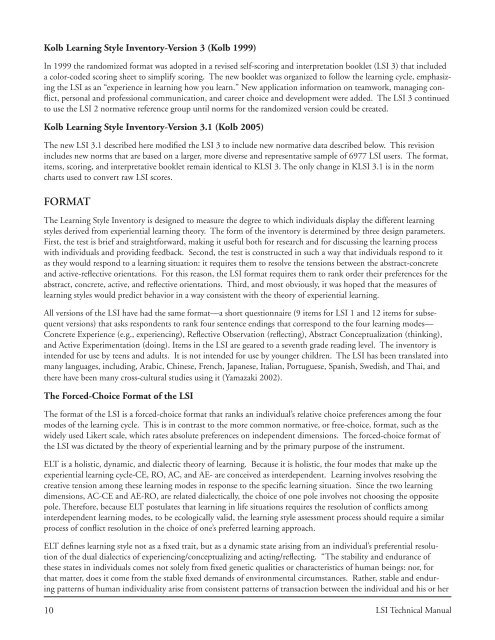The Kolb Learning Style Inventory—Version 3.1 2005 - Whitewater ...
The Kolb Learning Style Inventory—Version 3.1 2005 - Whitewater ...
The Kolb Learning Style Inventory—Version 3.1 2005 - Whitewater ...
Create successful ePaper yourself
Turn your PDF publications into a flip-book with our unique Google optimized e-Paper software.
<strong>Kolb</strong> <strong>Learning</strong> <strong>Style</strong> Inventory-Version 3 (<strong>Kolb</strong> 1999)<br />
In 1999 the randomized format was adopted in a revised self-scoring and interpretation booklet (LSI 3) that included<br />
a color-coded scoring sheet to simplify scoring. <strong>The</strong> new booklet was organized to follow the learning cycle, emphasizing<br />
the LSI as an “experience in learning how you learn.” New application information on teamwork, managing confl<br />
ict, personal and professional communication, and career choice and development were added. <strong>The</strong> LSI 3 continued<br />
to use the LSI 2 normative reference group until norms for the randomized version could be created.<br />
<strong>Kolb</strong> <strong>Learning</strong> <strong>Style</strong> Inventory-Version <strong>3.1</strong> (<strong>Kolb</strong> <strong>2005</strong>)<br />
<strong>The</strong> new LSI <strong>3.1</strong> described here modifi ed the LSI 3 to include new normative data described below. This revision<br />
includes new norms that are based on a larger, more diverse and representative sample of 6977 LSI users. <strong>The</strong> format,<br />
items, scoring, and interpretative booklet remain identical to KLSI 3. <strong>The</strong> only change in KLSI <strong>3.1</strong> is in the norm<br />
charts used to convert raw LSI scores.<br />
FORMAT<br />
<strong>The</strong> <strong>Learning</strong> <strong>Style</strong> Inventory is designed to measure the degree to which individuals display the different learning<br />
styles derived from experiential learning theory. <strong>The</strong> form of the inventory is determined by three design parameters.<br />
First, the test is brief and straightforward, making it useful both for research and for discussing the learning process<br />
with individuals and providing feedback. Second, the test is constructed in such a way that individuals respond to it<br />
as they would respond to a learning situation: it requires them to resolve the tensions between the abstract-concrete<br />
and active-refl ective orientations. For this reason, the LSI format requires them to rank order their preferences for the<br />
abstract, concrete, active, and refl ective orientations. Third, and most obviously, it was hoped that the measures of<br />
learning styles would predict behavior in a way consistent with the theory of experiential learning.<br />
All versions of the LSI have had the same format—a short questionnaire (9 items for LSI 1 and 12 items for subsequent<br />
versions) that asks respondents to rank four sentence endings that correspond to the four learning modes—<br />
Concrete Experience (e.g., experiencing), Refl ective Observation (refl ecting), Abstract Conceptualization (thinking),<br />
and Active Experimentation (doing). Items in the LSI are geared to a seventh grade reading level. <strong>The</strong> inventory is<br />
intended for use by teens and adults. It is not intended for use by younger children. <strong>The</strong> LSI has been translated into<br />
many languages, including, Arabic, Chinese, French, Japanese, Italian, Portuguese, Spanish, Swedish, and Thai, and<br />
there have been many cross-cultural studies using it (Yamazaki 2002).<br />
<strong>The</strong> Forced-Choice Format of the LSI<br />
<strong>The</strong> format of the LSI is a forced-choice format that ranks an individual’s relative choice preferences among the four<br />
modes of the learning cycle. This is in contrast to the more common normative, or free-choice, format, such as the<br />
widely used Likert scale, which rates absolute preferences on independent dimensions. <strong>The</strong> forced-choice format of<br />
the LSI was dictated by the theory of experiential learning and by the primary purpose of the instrument.<br />
ELT is a holistic, dynamic, and dialectic theory of learning. Because it is holistic, the four modes that make up the<br />
experiential learning cycle-CE, RO, AC, and AE- are conceived as interdependent. <strong>Learning</strong> involves resolving the<br />
creative tension among these learning modes in response to the specifi c learning situation. Since the two learning<br />
dimensions, AC-CE and AE-RO, are related dialectically, the choice of one pole involves not choosing the opposite<br />
pole. <strong>The</strong>refore, because ELT postulates that learning in life situations requires the resolution of confl icts among<br />
interdependent learning modes, to be ecologically valid, the learning style assessment process should require a similar<br />
process of confl ict resolution in the choice of one’s preferred learning approach.<br />
ELT defi nes learning style not as a fi xed trait, but as a dynamic state arising from an individual’s preferential resolution<br />
of the dual dialectics of experiencing/conceptualizing and acting/refl ecting. “<strong>The</strong> stability and endurance of<br />
these states in individuals comes not solely from fi xed genetic qualities or characteristics of human beings: nor, for<br />
that matter, does it come from the stable fi xed demands of environmental circumstances. Rather, stable and enduring<br />
patterns of human individuality arise from consistent patterns of transaction between the individual and his or her<br />
10 LSI Technical Manual


